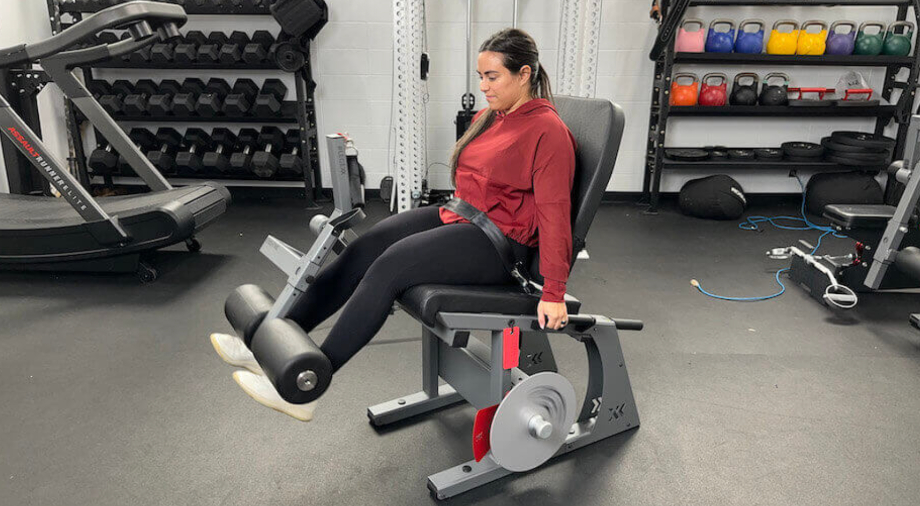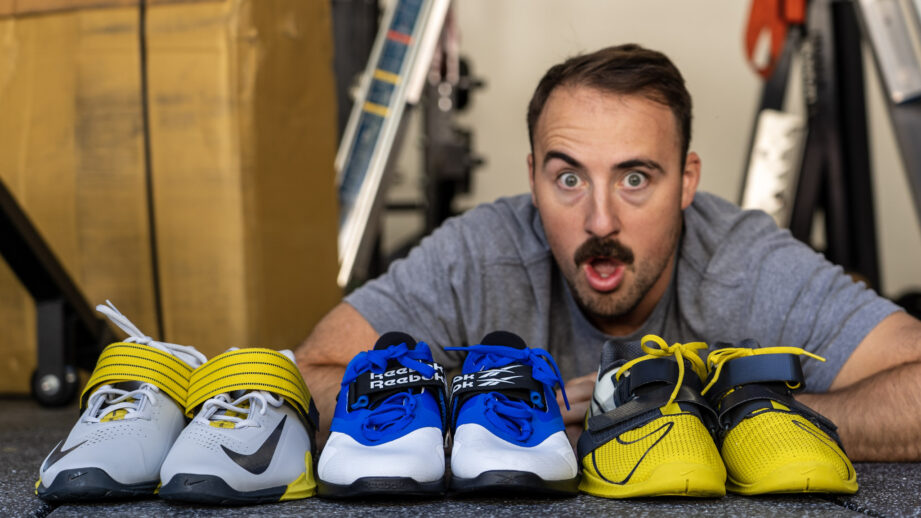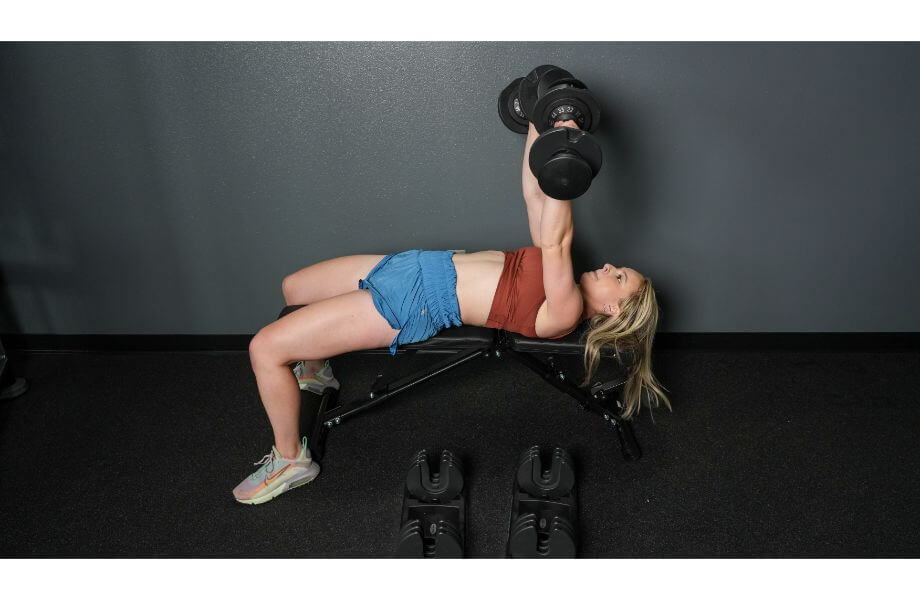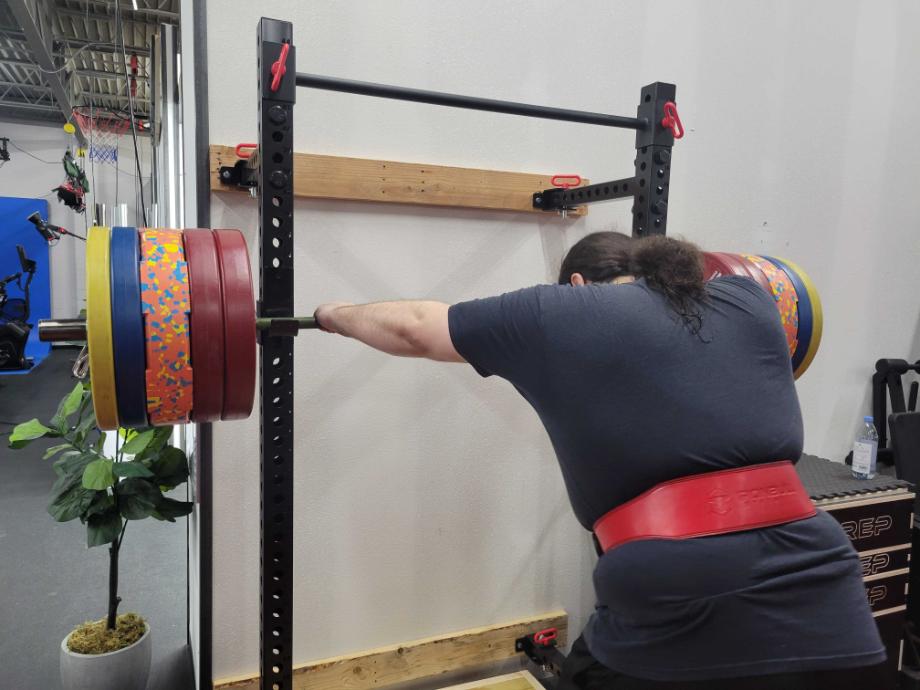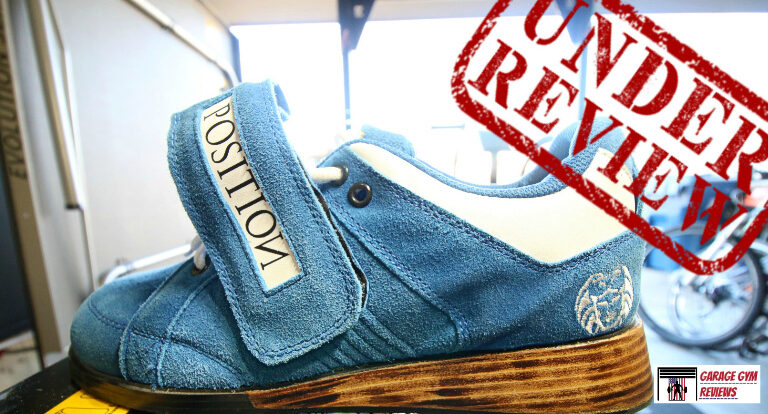Leg day is polarizing.
On the one hand, many fitness enthusiasts worldwide understand the numerous benefits associated with getting in a comprehensive leg workout on the reg. On the flipside, lots of gym goers bemoan the polarizing practice that we call “leg day,” dreading it and sometimes leaving it off the schedule altogether.
We get it. Leg day is hard! But that doesn’t make it any less important to your overall physical fitness and health.
A routine chock full of leg exercises like the squat, lunge, leg press, leg curl, and quad extension will work wonders for your lower body. Today, we’re honing in on the quad extensions, breaking down the exercise, how to perform it, its benefits, and other tips that will help you progress toward your personal fitness goals.
With a little knowledge and some pro tips from our team, we’re sure you’ll find leg day just a little less scary moving forward.
Quadriceps 101
Before we get into the exercise, let’s talk a little about your quadriceps, where they are, and what they do.
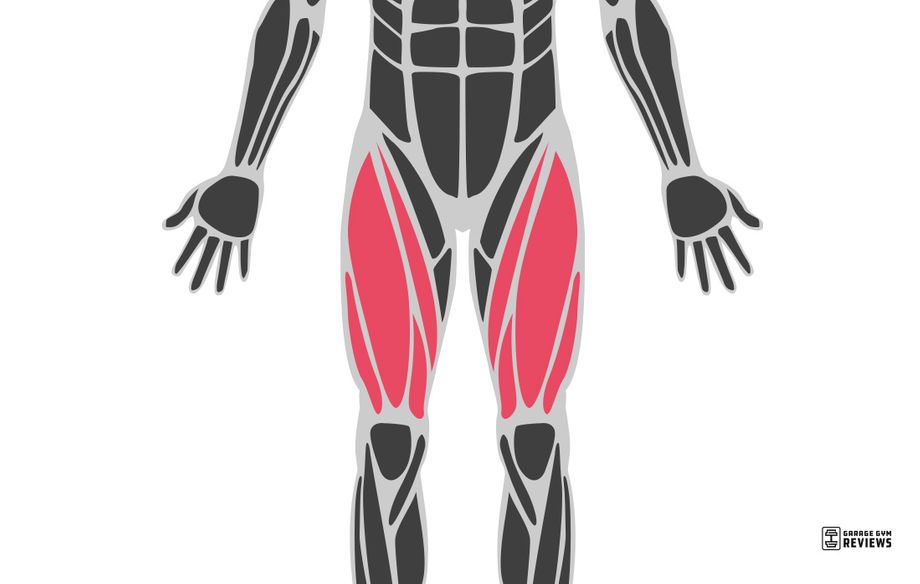
The quadriceps muscle is a large, four-headed muscle located on the front of your thigh. Along with the gluteus maximus and latissimus dorsi, the quadriceps are among the largest muscle groups of the body.
The quadriceps consist of the rectus femoris, vastus lateralis, vastus medialis, and vastus intermedius, all of which work together to extend the knee joint during common movements like walking, running, and jumping.
Strong quadriceps help stabilize the knee and reduce your risk of injury. They also work in conjunction with the hamstrings and calves to allow you to move smoothly and efficiently.
Given the important role your quads play, not only in sport performance but in everyday activities as well, it’s crucial to incorporate strength training exercises like the quad extension.
What Are Quad Extensions?
Quad extensions are a popular isolation exercise, predominantly targeting your quadriceps while providing some ancillary strengthening to the patellar ligament of the knee as well. They are typically performed seated at a leg extension machine, but variations may be performed using resistance bands, free weights, and a chair or bench.
Bodybuilders love big quads, using quad extensions to target and build the teardrop-shaped vastus medialis. Athletes employ quad extensions as well for its benefits in strengthening the rectus femoris, the largest of the four heads which assists in hip flexion and enables kicking and lunging motions.
How to Do Quad Extensions
Most gyms have multiple leg extension machines, as it is a popular exercise. Your home, on the other hand, may not. That’s why we’re providing a handy how-to guide for performing quad extensions both with a machine and without.
Starting with the leg extension machine method:
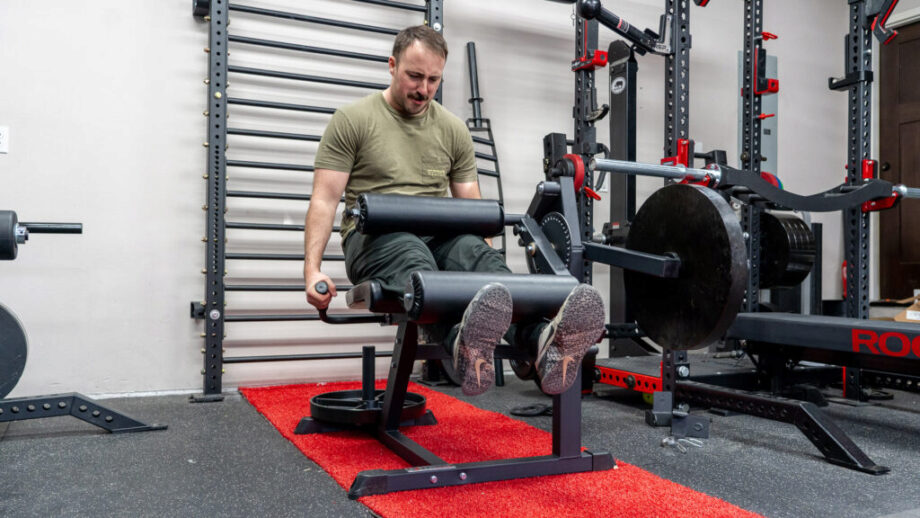
- Select the appropriate weight and sit down with your back against the padded support. Your knees should be bent at a 90-degree angle. The tops of your ankles should rest against the lower pads. This is your starting position.
- Grasp the handles on the sides of the machine and slowly straighten your legs, pushing against the weight, until your knees are fully extended.
- Hold the position for a moment, and then slowly return to the starting position.
- Repeat as needed.
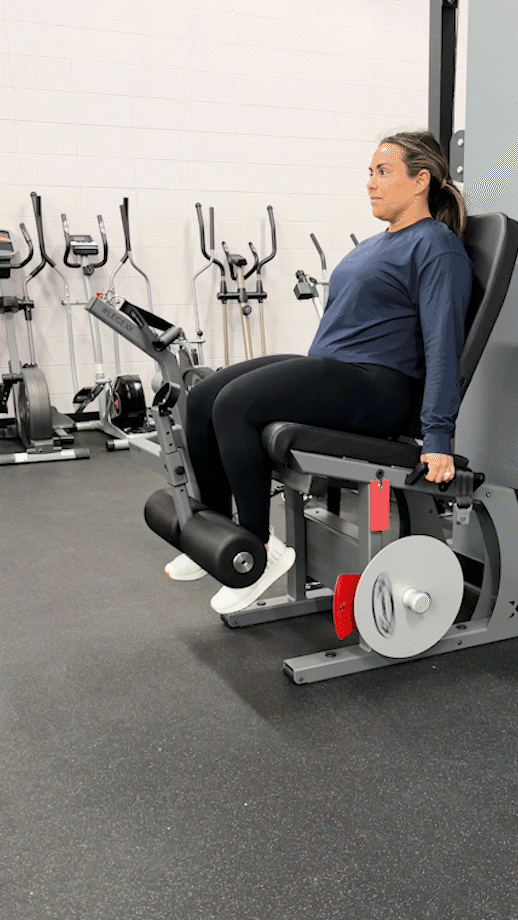
No leg extension machine? No problem!
Here’s how to perform quad extensions without a dedicated machine available:
- Sit on a chair or bench. As with the machine version, you will start with your knees bent. For resistance, you may choose to hold a free weight between your feet, use ankle weights, or anchor a resistance band beneath you and wrap the other end to a sturdy anchor point beneath you.
- Slowly straighten your legs, fighting the resistance, until your knees are fully extended.
- Hold the position for a moment, and then slowly return to the starting position.
- Repeat as needed.
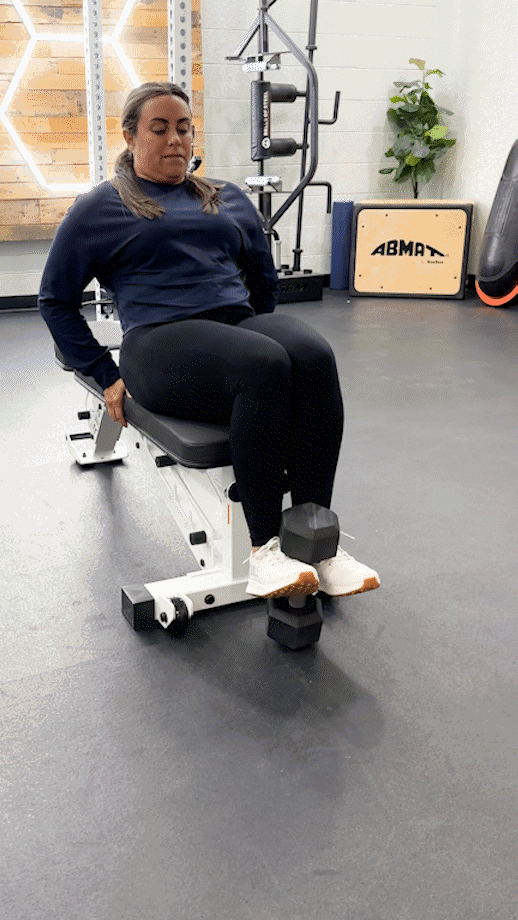
Trainer Tips for Quad Extension Form
The quad extension is a simple movement but, as with all exercises, proper form is key to maximizing the impact and reducing your risk of injury.
Here are our trainer tips for proper quad extension form:
Keep Your Back Straight and Core Engaged
Most exercises discourage any rounding of the back.
A rounded back is dangerous, placing undue stress on the muscles, discs, and ligaments of the lower back and significantly increasing the risk of injuries like herniated discs. Rounding your back during the quad extension also decreases the activation of your quadriceps, making the movement overall less effective.
Practice maintaining a flat back and neutral spine throughout the full range of motion, and engage your core to improve stability. This maximizes the effect of the exercises and reduces your risk of injury.
Move in a Slow, Controlled Manner
Again, the common advice for most lifts and exercises applies here. Jerky motions increase the risk of injury and make it more difficult to maintain proper form from start to finish. It also tends to reduce your time under tension, which minimizes the overall impact of the exercise.
That’s no bueno.
Moving slowly and in a controlled fashion maximizes your muscle activation, making those reps really count!
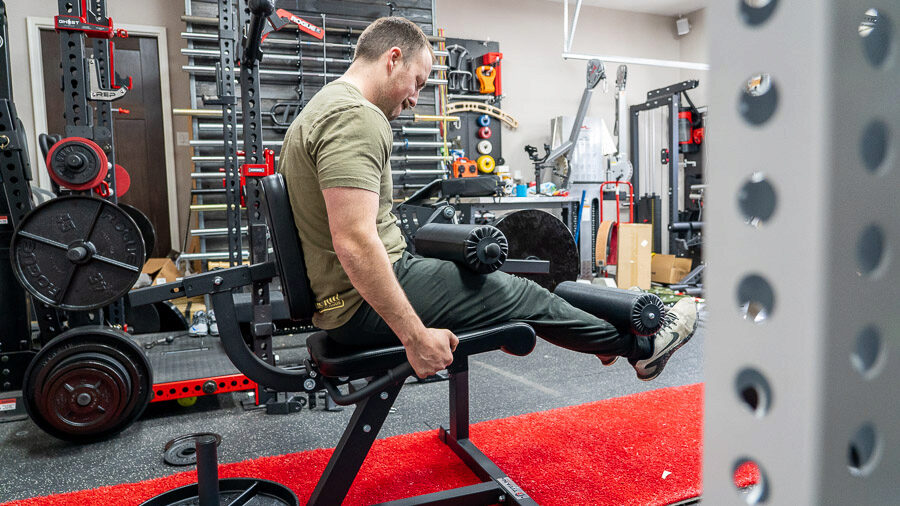
Start Small
The best way to hone in on proper form is by starting with light weights or light resistance and really prioritizing the biokinetics of the exercise.
“Light” is a relative term that won’t be universal for everyone, but starting small is the best way to find your true threshold. After all, you can always add more weight if it’s too easy, but going too heavy too soon sometimes is not apparent until it’s too late.
Look for a weight or resistance you can comfortably complete 12 to 15 reps while maintaining good form and proper alignment. This will help build a great foundation for the quad extension and prepare you for heavier weights as you gain familiarity with the movement.
Common Quad Extension Mistakes
Because of how simple and straightforward the quad extension is, it’s easy to make mistakes that will compromise your results and possibly your safety as well.
Here are some of the most common mistakes associated with the quad extension:
Don’t Round Your Back
Rounding the back doesn’t just reduce the impact of the muscle activation in your quads. It also puts you in a prime position to suffer nasty injuries like herniated discs. Keep that back flat and your core tight to avoid slouching or rounding during the movement.
Don’t Jerk or Use Momentum
This isn’t the clean and jerk.
Jerky movements or rushing through the motion only increases your risk of injury and reduces the impact of the exercise, as you begin relying on momentum instead of your own quadricep strength.
Like the classic Usher song, take it nice and slow.
Don’t Lock the Knees and Keep Them in Line With Feet
A whole mess of things could happen if you compromise proper alignment.
That’s why, throughout the full range of motion, you want to make sure your knees are tracking in line with your feet and you don’t lock your knees once they’re fully extended. Not only does maintaining proper alignment improve the overall effectiveness of the exercise, it helps reduce your risk of injuries like patellar tendonitis and patellar subluxation.
Keep your knees and feet aligned and maintain a slight bend in the knee at the end of the movement to avoid undue stress on the knee joint.
Don’t Go in Cold
As with any exercise, it’s always best to do a proper warm-up and stretch before hitting your working sets. Compound exercises like bodyweight squats work nicely to get the blood pumping, as do lunges and Good Mornings. Cardio exercise helps as well, including walking, jogging, running, and even step-ups.
Because quad extensions are an isolation exercise, many people prefer saving them for the tail end of the workout. Do what you feel works best for you, or consult a certified personal trainer for personalized guidance, but it’s not a bad idea closing your session with quad extensions.
RELATED: The 10 Best Warm-Up Exercises, According To Experts
Quad Extension Variations
Variety is the spice of life! Use these variations to switch things up:
Single-Leg Quad Extension
The single-leg quad extension is a unilateral variant that helps correct imbalances by focusing on one leg at a time. Here’s how to do them with good form:
- Sit on a chair or bench with your knees bent. For resistance, you may choose to hold a free weight between your feet, use ankle weights, or anchor a resistance band beneath you and wrap the other end to a sturdy anchor point beneath you.
- Slowly straighten your legs, fighting the resistance, until your knees are fully extended.
- Hold the position for a moment, and then slowly return to the starting position.
- Repeat for the desired number of repetitions.
- Switch legs and repeat.

Quad Extensions With Dumbbells
What do you do if you don’t have a leg extension machine?
You’re free to use free weights, either by holding the dumbbell between your feet or by using a super nifty product called MonkeyFeet by Animal House Fitness.
MonkeyFeet are a safe, secure way to attach dumbbells to your feet, adding immense value to any home gym setup. If you’re looking for a quick and easy way to use dumbbells for a set of quad extensions at home, MonkeyFeet is an intelligent and effective way to make it happen.
If you’re dead set on holding onto that dumbbell for dear life though, it is possible. Place a vertical dumbbell between your feet, resting the top end on the top of your feet. Now lift your feet off the floor and lean back slightly while maintaining a flat back.
From this position, proceed to straighten your legs as you would during any other variation of the quad extension and voila– quad extension using a dumbbell!

Quad Extensions With Ankle Weights
If you’re not keen on machines, free weights, or specialty equipment like MonkeyFeet, you can also complete your set of quad extensions using a set of ankle weights. Simply fasten the ankle weights around your ankles, take a seat, and complete your quad extensions using the steps detailed above for other variations.
Easy peasy.
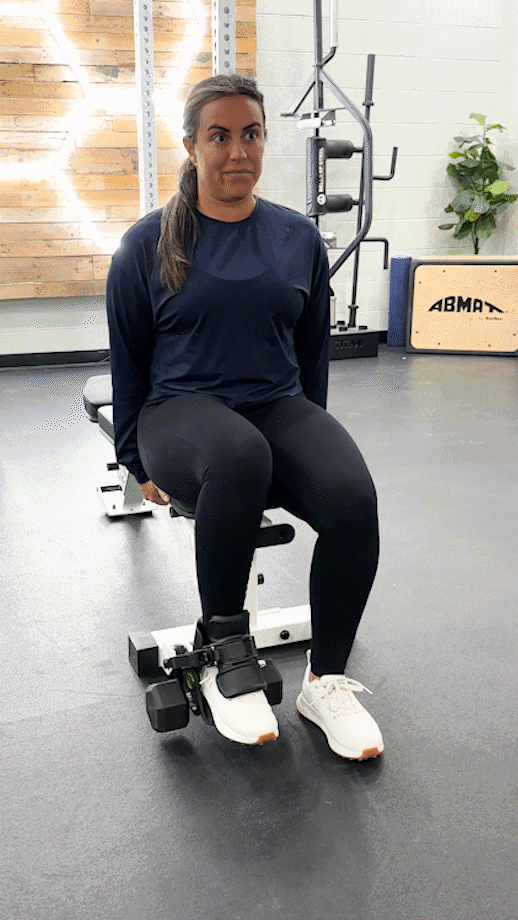
Benefits of Quad Extensions
Now that we know how to do quad extensions with perfect form, what can we use them for? What are the benefits of working quad extensions into our training program?
Quadricep Strengthening
Plenty of exercises strengthen the quadriceps, including back squats, Bulgarian split squats, lunges, leg presses– the list goes on. The main differentiator is that these exercises are compound exercises, providing activation across various lower body muscle groups instead of just the quadriceps.
The quad extension, on the other hand, almost exclusively targets your quadriceps, allowing you to focus all of your energy on the one goal of building the muscle strength of your quadriceps.
Quadricep Hypertrophy
Because the quad extension is an isolation exercise, it’s by far one of the best exercises for quadricep hypertrophy. That’s why it’s a staple in most bodybuilding routines.
In fact, a randomized controlled trial published in the Journal of Sports Sciences1 in 2021 compared quadricep hypertrophy from leg extensions compared to squats performed using a Smith machine. The results showed a significant difference in rectus femoris development, favoring leg extensions.
If you’re looking for bulging quads, the quad extension is a must.
RELATED: Build Your Dream Physique In The Comfort Of Your Home Gym
Knee Pain Relief
We strongly advise consulting a doctor and/or physical therapist before beginning any strength training program, especially if you are experiencing pain regularly or recovering from an injury. That said, research suggests quad extensions could ameliorate the intensity of knee pain and facilitate your ability to complete daily living activities painlessly.
A 2001 clinical trial published in the British Journal of Sports Medicine2 concluded that “leg extension/curl exercises can reduce the pain of jumper’s knee in a 12 week period and permit a high proportion of patients to return to sport.”
In addition, a 2014 study published in the Journal of Physical Therapy Science3 “concluded that quadriceps strengthening has beneficial effect on pain and function in patients with [osteoarthritis] knee” and “subjects having stronger quadriceps strength had less knee pain and better physical function as compared with those with the least strength.”
Furthermore, a 2019 double-blind randomized trial published by the British Journal of Sports Medicine4 determined that low-load leg extension exercises, combined with blood flow restriction, helped reduce patellofemoral pain caused by daily living activities by 93%.
The research shows that regularly completing sets of quad extensions, and other quad exercises that increase strength of the muscle group, help combat knee pain and support a healthier, more pain-free life.
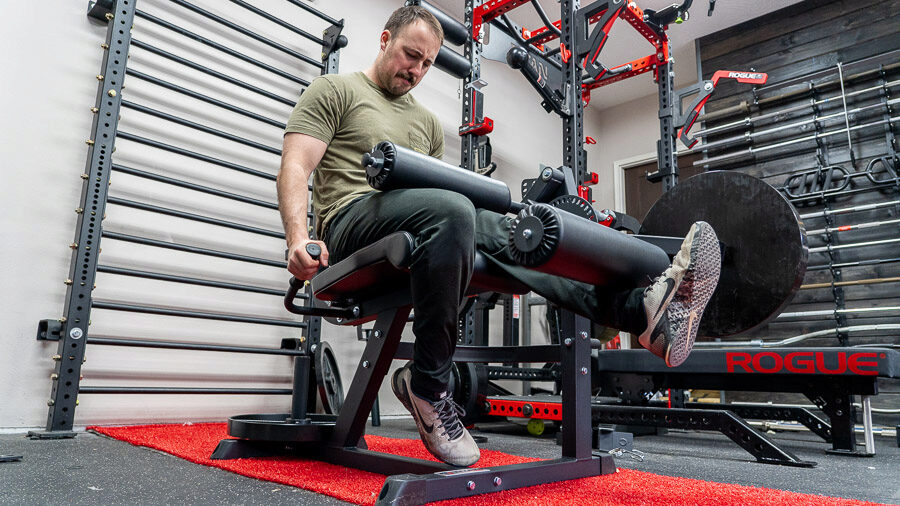
Rehabilitation
Quad extensions are also commonly used as part of rehabilitation programs for knee injuries, such as anterior cruciate ligament (ACL) tears, as a way to improve strength and stability in the knee joint over time.
In fact, a 2019 study published in the International Journal of Sports Medicine5 determined that the use of single-leg extensions, combined with blood flow restriction, was “feasible, safe and effective” and “can improve quadriceps function long after [ACL reconstructive surgery].”
Again, it’s crucial to consult a doctor and/or physical therapist before using quad extensions for recovery or rehabilitation. While it’s commonly used, it does not necessarily guarantee it’s right for your specific circumstances.
Are Quad Extensions Safe?
While many studies illustrate the benefits of quad extensions, the exercise has been the subject of controversy in the past. A 2017 article published by the National Strength and Conditioning Association in Personal Trainers Quarterly6 discussed the controversy at length–
“Some argue that the knee extension places tensile forces on the ACL, which can be considered dangerous, and instead, recommend exercises like squats. This perspective is not only shallow, but is also logically inconsistent. Indeed, tensile forces are placed on the ACL during the knee extension exercise. However, when examining these forces, it is important to bear in mind that they exist on a continuum, and injury is not a concern until a certain threshold is reached.”
According to the NSCA, the threshold at which injury occurs, roughly 2,000 Newtons, is significantly past the average tensile force applied during the quad extension, typically below 200 Newtons and more similar to everyday functional activities “such as walking.”
The NSCA did caution use of the quad extension for “symptomatic individuals,” but overall found the exercise to be safe in most applications–
“Nevertheless, if working with symptomatic individuals, exercise selection and range of motion should be tailored to the individual as per the recommendation of a physical therapist or medical professional; otherwise, the knee extension, like the squat, should not be considered universally contraindicated.”
Useful Quad Extension Equipment Accessories
Ready to work quad extensions into your routine at home? You’re going to need at least one of the following to get the job done:
Leg Extension Machine
The undisputed king of getting in your quad extensions, an actual leg extension machine will make getting in your reps an absolute pleasure.
We recommend the Exxentric SingleExx, as it’s great for leg extensions and leg curls too. Two machines for the price of one!
Resistance Bands
Is the leg extension machine a bit much?
A great set of resistance bands will help you perform quad extensions from the comfort of your home gym, and at a fraction of the cost!
Dumbbells
Some people don’t feel like they’re really building muscle unless they’re using a tried-and-true dumbbell. Luckily, you can get in a set of quad extensions with dumbbells using our above guide (and, oh, did we mention MonkeyFeet already?).
Ankle Weights
Ankle weights also are an excellent option for adding resistance to your quad extensions. Unlike resistance bands, there’s no need to find a sturdy anchor point and, unlike dumbbells, you won’t need to perform a delicate balancing act while eking out your reps.
Adding ankle weights to your quad extensions is a simple and effective way to increase challenge and improve your results.
Quad Extensions: Q&A
Should you go heavy on quad extensions?
It’s always recommended to start light when learning a new exercise and scale as you progress, but should quad extension veterans go heavy to get the most benefit from the exercise?
Actually, no.
The quad extension uses torque to move the weight. Typically, the weight is resting right on top of your ankles. Because it’s relatively far from the muscle that’s moving it, your quadricep, lighter weight will still provide ample benefit.
What is a good weight to use for quad extensions?
The weight you choose for quad extensions will depend entirely on your current fitness level and personal goals. As a starting point, we recommend selecting a weight you can comfortably complete 12 to 15 repetitions with while maintaining proper form and technique. This builds a strong foundation of strength and stability and prepares you for using heavier weights as you progress.
RELATED: How Many Reps To Build Muscle: Advice From A Certified Personal Trainer
Are quad extensions the same as leg extensions?
Quad extensions, leg extensions, and knee extensions are interchangeably used terms in exercise lingo and research studies regarding the quad-targeting, single-joint exercise we’ve been discussing throughout this article.
In most scenarios, these words refer to the same movement.
What are quad extensions good for?
Quad extensions are good for increasing strength, size, and stability of the quadricep muscles.
As a single-joint isolation exercise, they’re also very good for working to fatigue after a comprehensive leg day workout filled with compound exercises like squats, deadlifts, and other leg extension alternatives.
Do quad extensions make your legs bigger?
Many leg exercises help encourage hypertrophy of the quad muscles, but none get the job done quite like quad extensions. That’s why bodybuilders love working in sets of quad extensions in most leg day workouts.
In short, quad extensions absolutely make your legs bigger.
References
1. Zabaleta-Korta A, Fernández-Peña E, Torres-Unda J, Garbisu-Hualde A, Santos-Concejero J. The role of exercise selection in regional Muscle Hypertrophy: A randomized controlled trial. J Sports Sci. 2021;39(20):2298-2304. doi:10.1080/02640414.2021.1929736
2. Cannell LJ, Taunton JE, Clement DB, Smith C, Khan KM. A randomised clinical trial of the efficacy of drop squats or leg extension/leg curl exercises to treat clinically diagnosed jumper’s knee in athletes: pilot study. Br J Sports Med. 2001;35(1):60-64. doi:10.1136/bjsm.35.1.60
3. Anwer S, Alghadir A. Effect of isometric quadriceps exercise on muscle strength, pain, and function in patients with knee osteoarthritis: a randomized controlled study. J Phys Ther Sci. 2014;26(5):745-748. doi:10.1589/jpts.26.745
4. Giles L, Webster KE, McClelland J, Cook JL. Quadriceps strengthening with and without blood flow restriction in the treatment of patellofemoral pain: a double-blind randomised trial. Br J Sports Med. 2017;51(23):1688-1694. doi:10.1136/bjsports-2016-096329
5. Kilgas MA, Lytle LLM, Drum SN, Elmer SJ. Exercise with Blood Flow Restriction to Improve Quadriceps Function Long After ACL Reconstruction. Int J Sports Med. 2019;40(10):650-656. doi:10.1055/a-0961-1434
6. Tumminello, N., Vigotsky, A. Are the seated leg extension, leg curl, and adduction machine exercises non-functional or risky?. Personal Training Quarterly. National Strength and Conditioning Association; 2017: (4): 4.


